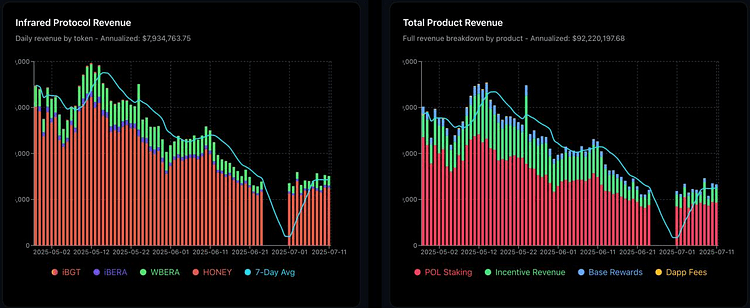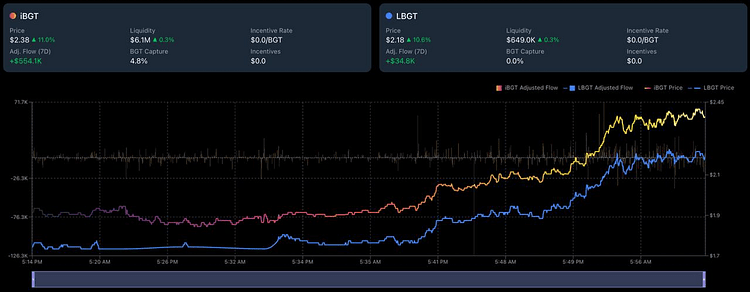In the short time since the launch of the Berachain mainnet, Infrared has rapidly risen to become the core protocol in the field of liquid staking within the ecosystem. Through differentiated product design, deep integration of economic models, and precise adaptation to Berachain's underlying mechanism (Proof of Liquidity), it has not only become the main entry point for users participating in staking but has also demonstrated significant competitive advantages in protocol revenue, governance influence, and ecological synergy. From an investment research perspective, Infrared's current market position and future potential warrant in-depth analysis.

Key role in the Berachain economic system
Infrared's core value is first reflected in its deep integration into Berachain's unique economic mechanism. Berachain's Proof of Liquidity (PoL) mechanism coordinates network security, liquidity supply, and governance participation through a dual-token model (BERA and BGT), while Infrared's three core products—liquid staking tokens (iBGT, iBERA) and PoL treasury (Vault)—cover all value flow segments of this mechanism. This complete coverage makes it one of the few protocols in the ecosystem capable of systematically capturing BGT issuance, and as a governance token, the long-term value of BGT is deeply tied to ecological development.

Data shows that Infrared currently handles about 80% of the daily average BGT issuance, meaning that out of every 10 newly generated BGT, 8 are allocated to users through Infrared's staking or treasury products. This dominant position not only strengthens the protocol's revenue capacity (annual gross profit reaching $85 million) but also makes it a practical hub of the Berachain governance system—through the voting rights of iBGT holders, Infrared indirectly influences the decision-making direction of key protocols within the ecosystem.
Competitive barriers in product design
Infrared's competitive moat stems from the irreplaceability of its product portfolio. Compared to similar protocols, its liquid staking token iBGT has maintained premium trading in the secondary market over the long term. This phenomenon is driven by two factors: first, the high liquidity of iBGT reduces users' exit friction; second, its yield distribution mechanism (with 80% of BGT issuance going to iBGT holders) creates sustained demand. For example, in DEX trading, the slippage of iBGT is significantly lower than that of competitors, while the staking annualized yield is higher than the average level, making it attractive to capital seeking efficiency.

Additionally, Infrared's PoL treasury further amplifies its revenue capture capacity. These treasuries provide users with opportunities for excess returns without active management through automatic compound strategies and cross-protocol integration (such as yield tiering with Pendle and lending combinations with Beraborrow). This 'yield aggregator' function makes it a fundamental component in Berachain's DeFi Lego—currently, leading protocols in the ecosystem, such as Kodiak and Dolomite, have chosen Infrared as their distribution channel for liquidity or governance tokens, further solidifying the network effect.
Revenue model and growth flywheel
From a financial performance perspective, Infrared has achieved a sustainable profit loop. Even during the early stages of low network activity on Berachain, the protocol has maintained about a 40% market dominance and is expected to reach a net income of $8 million by 2025. The significance of this data lies in the diversity of its revenue sources: staking service fees, treasury management profit sharing, and BGT incentive redistribution together form the revenue pillars.
It is worth noting that Infrared has strategically invested in ecological resources. As of now, the protocol has cumulatively spent over $2.5 million on voting incentives to strengthen the governance weight of iBGT. This cycle of 'revenue-reinvestment-share expansion' has created a virtuous growth flywheel: a higher market share leads to more BGT issuance capture, which in turn attracts more users and partners to join, ultimately benefiting the protocol's revenue. This model has been validated on mature chains such as Ethereum (Lido) and Solana (Marinade), and Infrared's first-mover advantage on Berachain makes it easier to replicate this path.

Ecological synergy and expansion potential
Infrared's growth potential is not limited to the staking business itself. As the Berachain ecosystem expands, its role as the primary distribution channel for BGT will become increasingly important. For example, new projects seeking community support through governance proposals must collaborate with iBGT holders; DeFi protocols aiming to attract liquidity can also directly integrate Infrared's staking tokens. This demand has led to deep binding between protocols—several teams have already incorporated Infrared into their economic model design, such as improving user retention rates through iBGT staking rewards.
In the future, Infrared may further expand through two paths: first, horizontally increasing the number of validation nodes to enhance network security and disperse risk; second, vertically developing specialized treasuries (such as optimization strategies for stablecoins or LP tokens) to meet segmented demands. If Berachain's total value locked (TVL) enters an explosive growth phase, Infrared's valuation logic as a foundational liquidity hub will undergo reassessment.
Core support for investment value
From an investment research framework, Infrared's value foundation is composed of three aspects: first, technical adaptability, as its protocol layer design is highly compatible with Berachain's PoL mechanism; second, economic model efficiency, with an 80% BGT issuance capture rate far exceeding that of competitors; third, ecological niche irreplaceability, with dependencies on leading protocols forming soft barriers.
Currently, Infrared's financial metrics have benchmarked against leading liquid staking protocols on mature chains, yet its valuation remains in the early stages. Considering Berachain's growth potential as a new public chain and Infrared's infrastructure position within it, the upward trajectory of its revenue scale and market share may be steeper than market expectations. For investors, Infrared at this stage not only represents a leading target in the liquid staking sector but also serves as a direct beneficiary of the Berachain ecosystem’s dividends.



